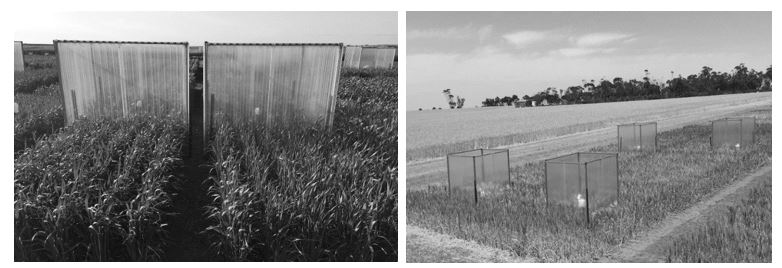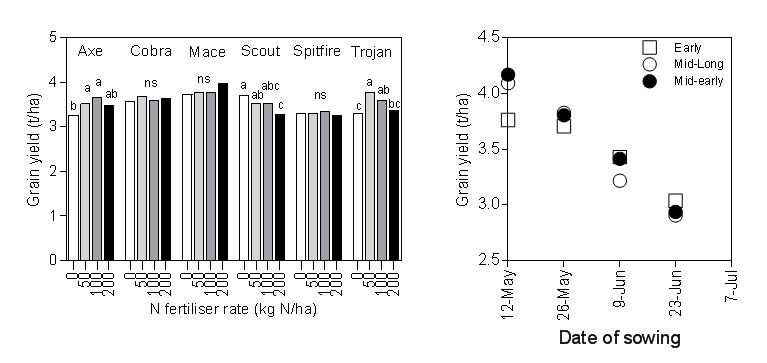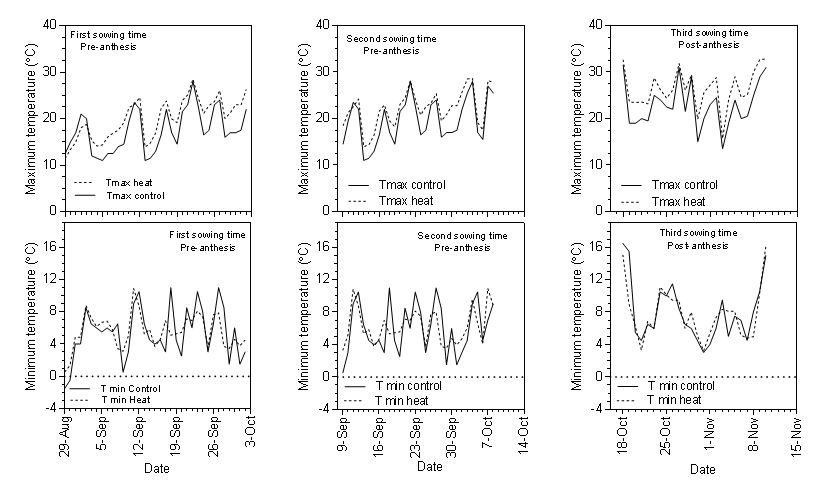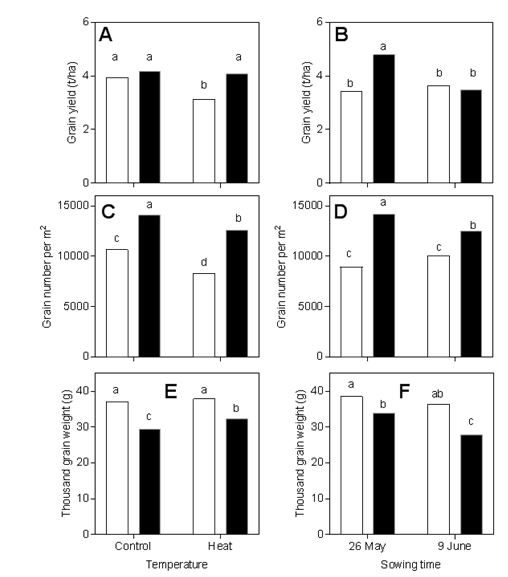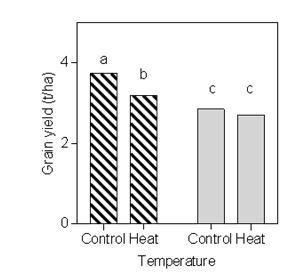Combined effect of elevated temperature and nitrogen supply on wheat yield
Author: C. Mariano Cossani and Victor O. Sadras (South Australian Research and Development Institute (SARDI)) | Date: 12 Feb 2019
Take home messages
- Nitrogen (N) rate needs to be adjusted to account for (a) sowing date, (b) cultivar, in order to capture the potential of new cultivars, and (c) elevated temperature.
- A modest increase of temperature; <1.7oC above ambient before flowering, reduced grain number and yield in unfertilised crops but not in fertilised crops.
- Nitrogen rate could be tailored to partially mitigate the effect of elevated temperature.
Background
Nitrogen (N) management remains one of the most important and risky decisions for wheat growers (Monjardino et al., 2015). Breeding for yield over the past six decades has resulted in cultivars that take up more N from soil (Sadras and Lawson, 2013). This means that N rates need to be adjusted to account for the increasing potential of new cultivars and to avoid mining soil organic matter reserves. Combined with cultivar choice, sowing date seeks to manage the dual risks of frost and heat. The sowing time shifts the thermal regime of the crop at critical stages, especially flowering. Both sowing time and cultivar also modify crop growth and N requirements. The interaction between N availability and temperature is largely unknown. The objective of this work was to study the effect of elevated temperature, sowing time, cultivar, and N rate on wheat yield.
Method
Field trials were carried out at Hart and Turretfield in 2017. At each site, factorial experiments were established combining four sowing times, six wheat cultivars, and four N rates. Sowing dates were from early May to late June. Cultivars were Axe, Cobra, Mace, Scout, Spitfire and Trojan and were chosen to capture variation in N requirements and phenology based on consultation with the local leaders of the National Variety Trials. Nitrogen treatments consisted of an unfertilised control, and three fertiliser rates (50, 100 and 200kg N/ha as urea) split in two equal applications at early tillering and just before stem elongation. Treatments were allocated to a split-split-plot with sowing times in the main plot, cultivars in the sub-plots, and N rates in the sub-sub plots with three repetitions for each experimental unit.
To untangle the effect of temperature and confounded effects with photoperiod and other weather variables, open-top chambers were used to manipulate temperature in a subset of treatments (Figure 1). Heated treatments were established with ‘heating cubes’ (Figure 1) and unheated controls, in combination with three sowing times, two cultivars (Mace and Spitfire), and two N rates (0 and 100 kg N/ha). The timing of heating was from booting to 10 days after anthesis (in the first and second sowing time) and from 10 days after flowering till maturity (third sowing time).
Figure 1. Open-top passive heating system before anthesis (left) and during grain filling (right).
Results and discussion
Yield response to sowing time, location, N rate and cultivar
Grain yield was affected by sowing time, location, N rate and cultivar (P<0.0001). Grain yield in Hart was higher than in Turretfield, by 1.2t/ha in early to mid-May sowing to 0.5t/ha in the mid to late June (Figure 2). Mace was the highest yielding cultivar (4.3t/ha in first sowing) and Spitfire was the lowest at the first (3.8t/ha) and last sowing (2.7t/ha). Axe did not show any advantage when sown early. Sowing early increased yield provided N availability (soil + fertiliser) was above 150kg N/ha. In Hart, N fertilisation increased grain yield in the first and second sowings (before June) while fertiliser did not affect yield in early or late June sowing. In Turretfield, where initial soil N was exceptionally high (279kg N/ha), N fertilisation reduced grain yield in the first sowing with no effect in the later sowings (Figure 2).
Figure 2. Grain yield as a function of sowing date and N rate at Hart and Turretfield in 2017. Data are averages across cultivars. Initial soil N was 111kg/ha at Hart and 279kg/ha at Turretfield.
The response of cultivars to N depended on sowing time and location (Figure 3, left panel). The early maturing Axe and the mid to long maturing Trojan increased yield in response to N, while the mid-season cultivars; Mace, Cobra and Spitfire did not. Scout did not respond to N up to 100kg N/ha and had a yield reduction with 200kg N/ha. For all cultivars, yield declined at a rate of 26kg grain/ha per day delay in sowing (Figure 3, right panel). Axe had lower yield than other cultivars in the first sowing probably due to untimely stress at critical stages.
Figure 3. Average response of cultivars to N rate (left panel) and to sowing time (right panel). Different letters indicate significant differences in yield among N rates.
Effects of temperature, and interactions with nitrogen
The temperature in the heated treatments followed closely the trajectory of the temperature of untreated controls, thus providing a realistic system for comparisons (Figure 4). On average, the heating system increased mean temperature by 1.4°C for the first and second sowing times, and 1.7°C during the late stages of the third sowing time. The increase of the mean temperature was associated with higher maximum temperature with little change in minimum temperature.
Warming before flowering
Grain yield of both cultivars was affected by temperature (P<0.05), sowing time (P<0.05) and N (P < 0.005). Nitrogen applications increased yield by 1.4t/ha in the first sowing (26 May) and had no effect on the second sowing (9 June). Delayed sowing reduced grain yield of fertilised crops but not for their unfertilised counterparts. Warming before anthesis reduced grain yield in unfertilised crops but not in fertilised crops (Figure 5A). Increasing temperature before anthesis and N affected both grain number and kernel weight in both sowing times. Elevated temperature reduced grain set by 15%. Applying 100kg N/ha increased grain set by 50% in the first sowing and 24% in the second sowing time. Delayed sowing decreased the grain number but only in fertilised crops (Figure 5D). Delayed sowing reduced kernel weight by 19% under high N but not in unfertilised crops (Figure 5F). The heating treatments during pre-anthesis did not reduce kernel weight.
Figure 4. Dynamics of maximum (Tmax) and minimum (Tmin) temperatures in heated treatments (dotted lines) and controls (solid lines) during the heating period for the three sowing times at Hart.
Figure 5. Main effect of the temperature (left) and sowing time (right) on grain yield (A, B), grain number (C, D), and thousand grain weight (E, F) for unfertilised (white bars) and fertilised crops (black bars). Different letters indicate significant differences (P < 0.05).
Warming after flowering
For crops sown on 23 June, Mace (3.46t/ha) out-yielded Spitfire (2.78t/ha). Increasing mean temperature by 1.7°C, reduced the yield of Mace by 15% but did not affect Spitfire’s yield (Figure 6). Nitrogen did not affect grain yield.
Figure 6. Main effect of temperature during post-anthesis for grain yield for Mace (diagonal line bars) and Spitfire (grey bars). Different letters indicate significant differences.
Grain number was affected by cultivar, temperature, and N. Mace produced approximately 2150 grains more per m2 than Spitfire. Increasing temperatures reduced grain number by 11% on average, with higher effect under fertilised conditions. Nitrogen fertilisation increased grain number and reduced kernel weight.
Note of caution: In this paper, we are reporting only the results from the first year of experiments, given that the second experimental year is being processed. This paper is informative and should not be taken, on its own, as a guideline.
Conclusion
In this first year of experiments a combined effect of the temperature and N on grain yield and yield components of wheat was found. In general, the increase in mean temperatures due to the warming chambers produced a penalty in grain yield as a consequence of reductions in both grain number and grain weight. However, the yield penalty was not significant when warming occurred on fertilised crops indicating that N rate could be tailored to partially mitigate the effect of elevated temperature.
Useful resources
References
Monjardino, M., McBeath, T., Ouzman, J., Llewellyn, R., and Jones, B. (2015). Farmer risk-aversion limits closure of yield and profit gaps: A study of nitrogen management in the southern Australian wheatbelt. Agricultural Systems 137, 108-118.
Sadras, V. O., and Lawson, C. (2013). Nitrogen and water-use efficiency of Australian wheat varieties released between 1958 and 2007. European Journal of Agronomy 46, 34-41.
Acknowledgements
The research undertaken as part of this project is made possible by the significant contributions of growers through both trial cooperation and the support of the GRDC, the authors would like to thank them for their continued support. Special thanks are given to Sarah Noack and HART Field-Site group, J. Fernandez-Lopez, G. Sepulveda and B. Sleep for their support and collaboration with the field and lab activities. We also acknowledge the help of Longreach and Australian Grain Technologies for their provision of the germplasm.
Contact details
C. Mariano Cossani
2c Hartley Grove, Climate Applications, SARDI, Waite Campus.
0437828185
mariano.cossani@sa.gov.au
A Varieties displaying this symbol are protected under the Plant Breeders Right Act 1994
GRDC Project Code: DAS00166_BA,
Was this page helpful?
YOUR FEEDBACK

